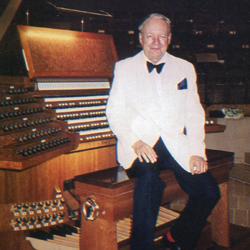
David Arthur Sansome Gell, 70 years old, died March 2, 2014, in Santa Barbara, California. Born in Alberta, Canada, his musical journey began at age 8 as a boy chorister in an Edmonton, Alberta, church. After immigrating to Alhambra, California, he began organ lessons at age 13.
Gell attended California State University at Los Angeles, majoring in history and music; he graduated in 1966 from Azusa Pacific University with a Bachelor of Arts degree in music, studying organ and theory with Gerald Faber. He did graduate study at the New Orleans Baptist Theological Seminary, the University of Hawaii (Manoa), and with Emma Lou Diemer at the University of California at Santa Barbara. During the Viet Nam conflict, he served on board the USS Klondike, and as organist and assistant to the Pacific Fleet Chaplain in Pearl Harbor.
David Gell served as organist and choirmaster at churches in Monrovia, California, New Orleans, Louisiana, and Trinity Evangelical Lutheran Church, First Congregational Church, and Good Shepherd Lutheran Church in Santa Barbara. His greatest distinction was as Minister of Music, Organist and Composer-in-Residence of Trinity Episcopal Church, Santa Barbara. During his 30-year tenure, he helped create several community concert series, including an Advent Series, Old Spanish Days Fiesta with La Música Antigua de España, Young Artists Concerts, and music and organ demonstrations to school children. He served as organist-in-residence at major cathedrals in Britain during five concert tours with the Santa Barbara Boys Choir.
Active in the American Guild of Organists, he had served as dean, sub-dean, and treasurer of chapters in Hawaii and Santa Barbara. He performed in Canada, Louisiana, Hawaii, and California, including at Our Lady of the Angels in Los Angeles and AGO regional conventions. He established the local chapter of the Choral Conductors Guild and served as founder, first conductor, and president of the board of the Santa Barbara Master Chorale.
David Gell composed works for orchestra, vocal solo, choral anthems and cantatas, concertos for instruments, fanfares, an organ sonata, string quartet, chorale preludes, and hymn introductions and intonations for the Episcopal Church’s 1982 Hymnal. Gell generously shared his scores, interpretation ideas, and ingenious methods of registration and of managing multiple pages of scores. His memorial service included music by his favorite composers—Buxtehude, Stanley, Handel, and Emma Lou Diemer. Two of his own organ compositions were included: “Meditation on Picardy” and “Toccata on ‘Only begotten, Word of God.’” In honor of his service in the Navy, Taps was played.
David Arthur Sansome Gell is survived by his wife of 45 years, Carolyn Gell. Memorial contributions may be made to the Azusa Pacific University School of Music, Organ Scholarship Advancement, P.O. Box 7000, Azusa, CA 91702-7000.
—Charles Talmadge


